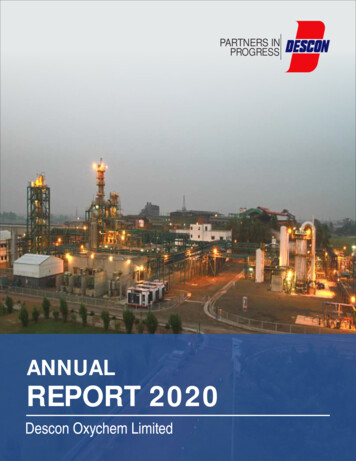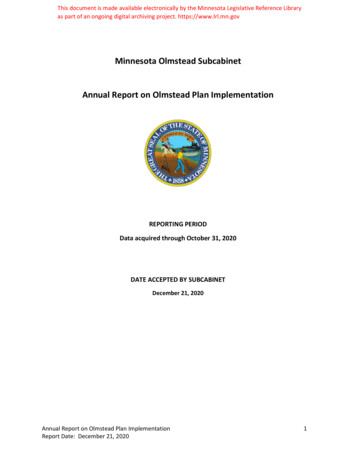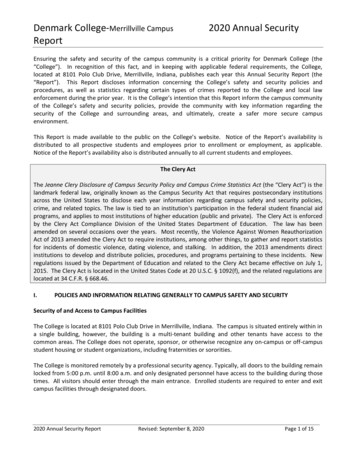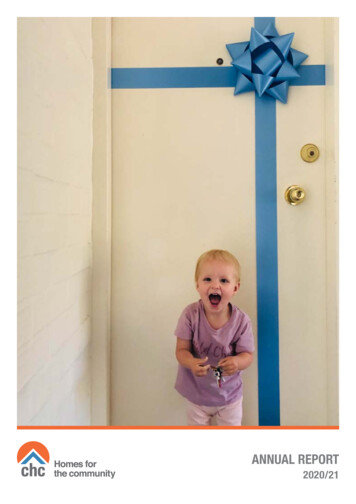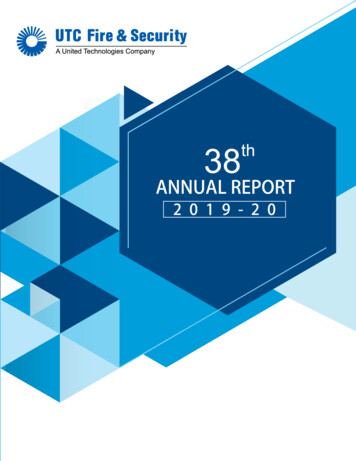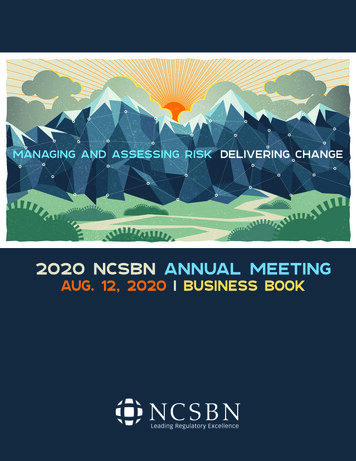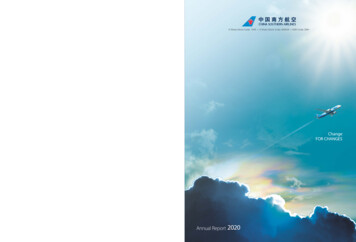
Transcription
China Southern Airlines Company 公司H Share Stock Code: 1055A Share Stock Code: 600029ADR Code: ZNH2020 Annual Report Mobile AppWeChat App
1About UsOperating ResultsAbout UsCorporate Governance2Definitions60 Report of Directors4Corporate Profile6Corporate Information83 C hanges in the Share Capital,Shareholders’ Profile andDisclosure of Interests8Company Business SummaryOperating Results21 Summary of Operating Data26 Summary of Fleet Data28 Highlights of the Year anagement Discussion and32 MAnalysis105 Corporate Governance Report118 CORPORATE BOND126 R ISK MANAGEMENT ANDINTERNAL CONTROL130 SOCIAL RESPONSIBILITYFinancial Statements Preparedunder International FinancialReporting Standards134 Independent Auditor’s Report139 Consolidated Income Statement140 C onsolidated Statement ofComprehensive Income141 C onsolidated Statement ofFinancial Position143 C onsolidated Statement ofChanges in Equity144 C onsolidated Cash FlowStatement145 N otes to the FinancialStatements248 S UPPLEMENTARYFINANCIAL INFORMATION252 FIVE YEAR SUMMARYFinancial Report20 P rincipal Accounting Informationand Financial Indicators92 D irectors, Supervisors, SeniorManagement and EmployeesFinancial ReportCorporate GovernanceContents
China Southern Airlines Company LimitedDefinitions2Unless the context otherwise requires, the following terms should have the following meanings in this report:Company, CSA, China Southern AirlinesChina Southern Airlines Company LimitedGroupChina Southern Airlines Company Limited and its subsidiariesCSAHChina Southern Air Holding Company LimitedXiamen AirlinesXiamen Airlines Company LimitedGuizhou AirlinesGuizhou Airlines Company LimitedZhuhai AirlinesZhuhai Airlines Company LimitedShantou AirlinesShantou Airlines Company LimitedChongqing AirlinesChongqing Airlines Company LimitedHenan AirlinesChina Southern Airlines Henan Airlines Company LimitedSAGASouthern Airlines General Aviation Co., Ltd.Hebei AirlinesHebei Airlines Company LimitedJiangxi AirlinesJiangxi Airlines Company LimitedFinance CompanyChina Southern Airlines Group Finance Company LimitedFreight and Logistic CompanySouthern Airlines Freight and Logistic (Guangzhou) Co., Ltd.CSAGPMCChina Southern Airlines Group Property Management Company LimitedNan LungNan Lung Holding LimitedSACCShenzhen Air Catering Co., Ltd.SACMSouthern Airlines Culture and Media Co., Ltd.SPVSpecial Purpose Vehicles exclusively set up by China Southern Airlines andits subsidiaries for leased aircraftSichuan AirlinesSichuan Airlines Corporation LimitedPRCThe People’s Republic of ChinaCSRCChina Securities Regulatory CommissionNDRCNational Development and Reform CommissionSASACState-owned Assets Supervision and Administration Commission of the StateCouncilCAACCivil Aviation Administration of ChinaIATAInternational Air Transport Association
Annual Report 2020Definitions3Stock ExchangeThe Stock Exchange of Hong Kong LimitedArticles of AssociationArticles of Association of China Southern Airlines Company LimitedListing RulesThe Rules Governing the Listing of Securities on The Stock Exchange ofHong Kong LimitedModel CodeThe Model Code for Securities Transactions by Directors of Listed Issuers asset out in Appendix 10 to the Rules Governing the Listing of Securities onThe Stock Exchange of Hong Kong LimitedCorporate Governance CodeCorporate Governance Code as set out in Appendix 14 to the RulesGoverning the Listing of Securities on The Stock Exchange of Hong KongLimitedSFOSecurities and Futures Ordinance (Chapter 571 of the laws of Hong Kong)Available Seat Kilometers or “ASK”the number of seats available for sale multiplied by the kilometers flownAvailable Tonne Kilometers or “ATK”the number of tonnes of capacity available for the transportation multiplied bythe kilometers flownAvailable Tonne Kilometers – passengerthe number of tonnes of capacity available for the carriage of passengermultiplied by the kilometers flownAvailable Tonne Kilometers – cargothe number of tonnes of capacity available for the carriage of cargo and mailmultiplied by the kilometers flownRevenue Passenger Kilometers or “RPK”i.e. passenger traffic volume, the number of passengers carried multiplied bythe kilometers flownRevenue Tonne Kilometers or “RTK”i.e. total traffic volume, the load (passenger and cargo) in tonnes multiplied bythe kilometers flownRevenue Tonne Kilometers –cargo or “RFTK”i.e. cargo and mail traffic volume, the load for cargo and mail in tonnesmultiplied by the kilometers flownRevenue Tonne Kilometers –passengerthe load for passenger in tonnes multiplied by the kilometers flownAircraft Daily Utilization RateFlight hours that aircraft can provide service during a dayPassenger Load FactorRPK expressed as a percentage of ASKOverall Load FactorRTK expressed as a percentage of ATKYield per RPKrevenue from passenger operations divided by RPKYield per RTKrevenue divided by RTKYield per RFTKrevenue from cargo and mail operations divided by RFTKFinancial ReportShanghai Stock ExchangeCorporate GovernanceSSEOperating ResultsBeijing Daxing International AirportAbout UsDaxing Airport
China Southern Airlines Company LimitedCorporateProfile4The Group is the biggest airline inChina with the largest fleet,the most extensive route network andthe largest annual passenger turnover.The Group’s headquarters is located in Guangzhou. It has 16 branches inBeijing, Shenzhen, and other cities and 8 holding aviation subsidiaries includingXiamen Airlines. The Company has set up SAGA in Zhuhai, and has set up 23domestic offices in Hangzhou, Qingdao and other places, and 55 overseasoffices in Sydney, New York, Tokyo and other places. By the end of 2020, theCompany has operated a total of 867 passenger and cargo transport aircraftincluding Boeing 787, 777, 737 series, Airbus 380, 350, 330, 320 series. In2020, the Group’s passenger turnover ranked first among Chinese airlines for42 consecutive years, and continued to rank first in Asia and at the forefront ofthe world. The Company has maintained the best safety record among Chineseairlines. The Company was awarded “Two-Star Diamond Award for FlightSafety”, the top award for flight safety from the CAAC, in June 2018 and hasbeen an airline with the highest safety star in China.
Annual Report 2020Corporate Profile5About Usin Guangzhou and BeijingFinancial ReportAS OF 2020, THE GROUP’SPASSENGER TURNOVERRANKED FIRST AMONGCHINESE AIRLINES FOR42 CONSECUTIVE YEARS,AND CONTINUED TO RANKFIRST IN ASIA AND AT THEFOREFRONT OF THE WORLD.Corporate ng ResultsIn recent years, the Company has strivento build two comprehensive internationalhubs in Guangzhou and Beijing, and anetwork-based airlines has gradually takenshape. In 2020, the Company continuedto strengthen the integrated constructionof the Guangdong-Hong Kong-MacaoGreater Bay Area, which promoted theflow of people, logistics, information andcapital in Guangdong Province and theentire Guangdong-Hong Kong-MacaoGreater Bay Area, and promoted theconnectivity between the GuangdongHong Kong-Macao Greater Bay Areacity cluster and major global city clusters.In 2020, the Company completed thetransit of all flights in Beijing hub toDaxing Airport, and the construction ofBeijing hub has entered a new era. TheGroup plans to operate an average ofmore than 400 flights per day at DaxingAirport, reaching more than 40 domestic destinations.By connecting with ground transportation, the Groupforms an airlines network that radiates the BeijingTianjin-Hebei region and the Xiong’ an New Area andconnects the country and the world, with utilised timeslots accounting for 45%, becoming the largest mainbase airlines in Daxing Airport.
China Southern Airlines Company LimitedCorporateInformation6Chinese Name:中國南方航空股份有限公司Chinese Short Name:南方航空English Name:China Southern Airlines Company LimitedEnglish Short Name:CSNLegal Representative:Ma Xu LunRegistered Address:Unit 301, 3/F, Office Tower Guanhao Science Park Phase I,12 Yuyan Street, Huangpu District, Guangzhou, Guangdong Province, PRCContact Address:China Southern Air Building, 68 Qixin Road, Baiyun District, Guangzhou,Guangdong Province, PRCPlace of Business in Hong Kong:Unit B1, 9th Floor, United Centre, 95 Queensway, Hong KongWebsite of the Company:www.csair.comTelephone: 86-20-86112480Fax: 86-20-86659040E-mail:ir@csair.comAPP:China Southern AirlinesWeChat Official Account:China Southern AirlinesSina Weibo:http://weibo.com/csairWeChat QR Code:Place of Listing of A Shares:SSEShort Name of A Shares:南方航空Stock Code of A Shares:600029A Share Registrar:China Securities Depository andClearing Corporation Limited, Shanghai BranchFloor 36, China Insurance Building,166 Lu Jia Zui East Road, Shanghai, PRCPlace of Listing of H Shares:The Stock Exchange
Annual Report 2020Corporate Information7Stock Code of H Shares:01055H Share Registrar:Hong Kong Registrars Limited17M Floor, Hopewell Centre, 183 Queen’s Road East, Hong KongPlace of Listing of N Shares:The New York Stock ExchangeShort Name of N Shares:China Southern AirStock Code of N Shares:ZNHN Share Registrar:BNY Mellon Shareowner ServicesP.O.Box 505000Louisville, KY40233-5000, USADomestic Legal Adviser:Dentons Law Offices, LLP (Guangzhou)Overseas Legal Adviser:Jingtian & Gongcheng LLPDomestic Auditors:KPMG Huazhen LLPOverseas Auditors:KPMG (Public Interest Entity Auditor registered in accordance withthe Financial Reporting Council Ordinance)Controlling Shareholder:China Southern Air Holding Company LimitedPrincipal Bankers:China Development BankThe Export-Import Bank of ChinaChina Construction BankIndustrial & Commercial Bank of ChinaAgricultural Bank of ChinaDesignated Website for InformationDisclosure (H Shares):www.hkexnews.hkPlace Where Annual Report is MadeAvailable for Inspection:The Board Office of the CompanyAs at 30 March 2021DirectorsMa Xu LunHan Wen ShengZheng FanGu Hui ZhongTan Jin SongJiao Shu GeSecretary to the Board andCompany Secretary:Xie BingSecurities Affairs Representative:Xu YangAuthorized Representativesunder the Listing Rules:Ma Xu LunXie BingOperating ResultsChina South AirAbout UsShort Name of H Shares:Corporate GovernanceFinancial ReportSupervisorsLi Jia ShiLin Xiao ChunMao Juan
China Southern Airlines Company LimitedCompanyBusiness Summary8I.The Principal Business andOperating Model of the Company and theIndustry Summary during the Reporting Period(I) Principal BusinessThe scope of business of the Company covers: (1) provision of scheduled andnon-scheduled domestic, regional and international air transportation servicesfor passengers, cargo, mail and luggage; (2) undertaking general aviationservices; (3) provision of aircraft repair and maintenance services; (4) acting asagent for other domestic and international airlines; (5) provision of air cateringservices (operated by branch office only); (6) engaging in other airline or airlinerelated business, including advertising for such businesses; (7) engaging inother aviation businesses and related businesses (limited to insurance agencybusiness personal accident insurance); provision of airline ground services; civilaircraft training (operated by branch office only according to licence); assetleasing services; project management and technical consultancy services; salesof aviation equipment; travel agency business; merchandise retail and wholesale.(For all projects subject to approval in accordance with laws, the businessactivities can only be carried out after obtaining approval by relevant authoritiesin accordance with the laws.)(II) Profit Model, Operating Characteristics andDevelopment StrategiesIt has always been the intent and purpose of the Company to build a strategicframework of “three-two-four-five-three” of world-class air transport enterprise.
Annual Report 2020Company Business Summary9Operating ResultsThe Company adheres to the “five development” concepts of safety, highquality, innovation, cooperation and sharing; focuses on the “five strategies” inrelation to hub network, ecosystem, innovation-driven, lean management andcontrol, and brand management; carries out “six campaigns” on promotingsafety production, grasping major strategic opportunities, deepening reforms inkey areas, enhancing management to first class, optimizing and adjusting fivemajor structures, improving service quality; and strives for “six transformations”from speed-oriented to quality-oriented, from comprehensive market expansionto exploring key areas, from a relatively single industry to high relevanceand diversified industries, from planning management and control to marketoperation, from the traditional business model to digitalization and ecologicalcircle, and from extensive management to refined management.About UsGuided by the development goals of the “14th Five-Year Plan” and the LongRange Objectives Through the Year 2035, we will further focus on qualityand efficiency, and have determined the overarching approach for qualitydevelopment, being “adhering to five concepts of development, implementingfive strategies, promoting six campaigns, and achieving six transformations”.(III) Development of Civil Aviation Industry andIndustrial Position of the Company(1) Development of International Aviation IndustryCargo volumes fallen, but prices raised, and cargo revenues bucked thetrend. According to data released by IATA, driven largely by the precipitousfall in global passenger demand and flight groudings, the capacity for cargodecreased by 23% year-on-year. The global air cargo volume was 54.20 milliontonnes, down from 61.30 million tonnes in 2019. At the same time, due tostrong demand for the transportation of anti-pandemic supplies, cargo revenuesgrew against the trend. The total cargo revenues of global airlines increased toUS 117.7 billion, representing an increase of 30% year-on-year.The recovery of the industry faces multiple challenges. According to IATA,the COVID-19 pandemic has caused severe financial damage to the industry.The debt level of global airlines has further risen, which weakens their abilityto respond to risks. The process of global relaxation of travel restrictions andquarantine measures is still uncertain, which depends on the progress of globalvaccination. According to IATA, the global air transport industry will remain in thered in 2021, and will not even turn a profit until 2022. As the crisis lasts longerthan expected, more government assistance is needed to recover the industry.Financial ReportPassenger demand dropped sharply and the revenue plummeted.According to data released by IATA, the global aviation industry has been deeplyaffected by the COVID-19 pandemic. In 2020, the global passenger trafficdemand significantly decreased by 65.9% year-on-year in terms of RPK, amongwhich, the international passenger transport demand significantly decreased by75.6% year-on-year. The industry-wide passenger revenue was expected to fallto US 191.0 billion, representing a decrease of two-thirds year-on-year. Thepassenger load factor was 62.8%, representing a decrease of 19.2 percentagepoints year-on-year.Corporate Governance1. Information of Development of International andDomestic Aviation Industry
China Southern Airlines Company Limited10(2) Development of China Aviation IndustryAccording to the data released by CAAC:Safety and operation. In 2020, China’s civil aviation transport achieved a safetyrecord in continuous safety flight of 124 months and 89.43 million hours, andsecured aviation safety for 18 consecutive years. The flight on-time performancerate in the China’s civil aviation industry reached 88.52%, representing anincrease of 20 percentage points from the end of the “12th Five-Year Plan”period. 233 airports were able to provide “paperless” travel service for domesticflights, and 41 domestic airlines implemented the “step rate” for ticket refundsand changes.Production and results. In 2020, China’s civil aviation achieved a total trafficvolume of 79.85 billion ton-kilometers, a passenger traffic volume of 420 millionand a cargo and mail transportation volume of 6.766 million tonnes. As of theend of 2020, the scale of China’s civil aviation fleet reached 6,747 aircraft; thetotal mileage of air routes in China reached 237,000 kilometers; and the numberof certified transportation airports nationwide amounted to 241, of which 39were ten-million-level airports.
Annual Report 2020Company Business Summary112. Features of Aviation IndustryAbout Us(1) The development level ofcivil aviation industry is an important display ofthe comprehensive national strengthThe civil aviation industry is an important strategic industry of the nationaleconomy. On one hand, its development level reflects the modernisation level,economy structure, opening level and other conditions of a country or a region.On the other hand, it is an important indicator to measure the national orregional economic competitiveness.(2) Civil aviation industry is featured with commonalityFinancial ReportCivil aviation industry is featured with high degree of technology content, longindustry chains and advanced technology-integration. The development of thecivil aviation industry provides vast room for the technological innovation ofrelated fields. Especially, the upstream aviation manufacturing industry may drivethe development and innovation of material, metallurgy, chemical, mechanicalmanufacturing, special processing,electronics, information and manyother industries. It is a strategicindustry and forerunner hightech industry for a country’seconomic development and animportant symbol of a country’smodernization, industrialization,science and technology, andcomprehensive national strength.Corporate Governance(3) Civil aviation industry is featured withhigh degree of technology contentOperating ResultsCivil aviation industry plays a role that other transport methods cannot replacein promotion of international communication, providing service for public travel,emergency rescue and disaster relief, and many other social and public services.Aviation passenger transport is the basis for the development of the tourismindustry and a safeguard for international political, economic and culturalcommunications. Aviation transport is routinely used for international transoceanicpassenger transport. Aviation cargo transport is a must for the developmentof trade, logistics, high-tech and many other industries and the basis for thedevelopment of courier and postal industry.
China Southern Airlines Company Limited12(4) Civil aviation industry is featured withhigh risks and high investmentsOn one hand, high risks are reflected in uncertainties in air transport. The unsaferisk sources are very complex and diverse. There are many uncontrollablefactors. Once there is any problem, the consequences are unthinkable. On theother hand, air transport are largely affected by political and economic situations,natural disasters and pandemic. The COVID-19 pandemic has caused asignificant impact on the global aviation industry. At the same time, fluctuation ofexchange rates, interest rates and aviation oil price will also affect the profits toa large extent. High investments are reflected in that airlines need to make hugeinvestments in fixed assets, including investment in capacity input, infrastructureand technology reconstruction, among which, the cost of introducing aircraft,operation cost, and maintenance cost are huge. Airlines also need to inputa huge fund for supporting infrastructure, facility, equipment and technologytransformation.3. Industrial Position of the CompanyThe Group is the biggest airline in China with the largest fleet, the most extensiveroute network and the largest annual passenger throughput. As at the end ofreporting period, the Group has operated a total of 867 passenger and cargotransport aircraft including Boeing 787, 777, 737 series, Airbus 380, 350, 330, 320series, etc. The Company maintains the best safety record among Chinese airlines.In June 2018, the Company was awarded “Two-Star Diamond Award for FlightSafety”, the top award for flight safety from the CAAC. The Company has been anairline with the highest safety star in China.
Annual Report 2020Company Business Summary13About UsOperating ResultsThe major challenges faced by the Group include:1. Impact of COVID-19 pandemicIn 2020, the COVID-19 pandemic spread globally. In order to control thepandemic, countries around the world successively adopted travel restrictions,which resulted in a sharp drop in global aviation passenger transport demand.China adopted strong pandemic prevention and control measures to take thelead in controlling domestic outbreaks. Both China’s economy and the domesticaviation demand gradually recovered. However, the overseas outbreak has notbeen effectively controlled, the restriction policies for international routes remainstrict, and the possible sporadic domestic outbreaks still have an adverse impacton the Company’s operations. The travel restrictions of various nations areexpected to be gradually lifted with the promotion of vaccination in the future.However, there are still huge uncertainties in the future recovery of aviationdemand as affected by the vaccination production and global distribution.Financial Report(IV) ChallengesCorporate GovernanceIn recent years, the Company has striven to build two comprehensiveinternational hubs in Guangzhou and Beijing, and a network-based airline hasgradually taken shape. In 2020, the Company continued to strengthen theintegrated construction of the Guangdong-Hong Kong-Macao Greater BayArea, which promoted the flow of people, logistics, information and capital inGuangdong Province and the entire Guangdong-Hong Kong-Macao GreaterBay Area, and promoted the connectivity between the Guangdong-Hong KongMacao Greater Bay Area city cluster and major global city clusters. In 2020, theCompany completed the transit of all flights in Beijing hub to Daxing Airport,and the construction of Beijing hub has entered a new era. The Group plans tooperate an average of more than 400 flights per day at Daxing Airport, reachingmore than 40 domestic destinations, through the connection with groundtransportation, thus forming a network that radiates the Beijing-Tianjin-Hebeiregion and the Xiong’an New Area and an airline network that connects thecountry and the world, with utilised time slots accounting for 45%, becomingthe largest main base airline at Daxing Airport.
China Southern Airlines Company Limited142. Expansion of high-speed rail networkAccording to the data released by China State Railway Group Co., Ltd., bythe end of 2020, China’s railway operating mileage had reached 146,300kilometers, of which high-speed rail mileage attained 37,900 kilometers.By 2035, the national railway network will reach about 200,000 kilometers,including about 70,000 kilometers of high-speed rail. Cities with a populationof over 500,000 will be connected with high-speed rail lines so as to form the1-2-3 hour travel range with high-speed rail. The operating speed of highspeed rail has continued to increase since 2007, with the maximum operatingspeed increasing from 250 kilometers per hour to 350 kilometers per hour.Further improvements are expected in the future. The operating results of theCompany’s routes that overlap with the high-speed rail network (especiallyroutes with mileage of no more than 800 kilometers) will be impacted in thefuture to a certain extent.3. Intensifying competition in the industryIn the domestic market, due to the impact of the COVID-19 pandemic, largetransport capacity of international routes has been transferred to domesticroutes. Thus, the supply-demand imbalance of the industry has intensifiedcompetition, and the ticket price of domestic routes may decline to a certainextent. In the international market, as the integration of the global aviationindustry is accelerating, small airlines may be acquired or go bankrupt, whilelarge airlines seek government assistance, which will impact the original structureof international cooperation.4. Exchange rate fluctuationIn 2020, as global trade shrank sharply due to the impact of the COVID-19pandemic, the monetary policies of developed countries were loosenedaccordingly, and the level of government debt reached a new high. Theinternational financial market experienced substantial turbulence. The flexibilityof RMB exchange rate continued to increase, but the overall trend was stillrelatively stable compared to other major currencies. Throughout the year, thespot exchange rate of RMB against US dollar showed an N-shaped trend offirst rising, then falling and rising again. Exchange rate fluctuations have ledto changes in the Company’s financial expenses and will directly affect theCompany’s performance.5. Crude oil pricesIn 2020, due to the complex and changeable global political landscape, and theincreasing downward pressure on the global economy, there were uncertaintiesfor both supply and demand sides of international crude oil. At the beginningof 2020, international crude oil prices continued to fall and fluctuated sharply,and then slowly rebounded in a V-shaped trend. Fluctuations in crude oil priceshave led to changes in the Company’s fuel costs and will directly affect theCompany’s performance.
Annual Report 2020Company Business Summary15(V) Security Ensurence InputSecond, we made efforts to promote the construction of seven major safetysystems. We have actively promoted the construction of seven major safetysystems centered on safety responsibility, regulations and manuals, training,process control, risk management and control, safety culture and technologicalinnovation, as a way to build and improve the safety management and controlsystem, and further strengthen the systematicness and coordination of theCompany’s safety management.II.Analysis on the Core Competitivenessduring the Reporting Period1.Powerful and well-rounded scale and network advantages. The Companyhad the largest fleet in China and advanced fleet performance. The Grouphas the densest network by forming a developed route network coveringChina, and the rest of Asia, and effectively connecting Europe, America,Australia and Africa. With the largest volume of passenger traffic, theCompany is the first airline in China with its amount of passenger trafficexceeding 100 million. At present, the Company has 16 branches in Beijing,Shenzhen and other cities and 8 holding aviation subsidiaries, includingXiamen Airlines. Establishment of branches and subsidiaries createdadvantages to better coordinate resources including local market, airports,large customers, channels and media, and supply transiting customers tothe hubs. Meanwhile, the Company set up 7 regional marketing centersand has 23 domestic offices and 55 overseas offices in all continents.The Company has formed a comprehensive sales network with branches,holding subsidiaries, regional marketing centers and offices.Financial ReportThe Company’s five core competitive strengths have begun to take shape,including its powerful and well-rounded scale and network advantages, its huboperations and management capability with Guangzhou-Beijing as its dual corehubs, its resource synergy capabilities combined with integrated operation andmatrix management, its influential, high quality brand service and comprehensiveleading information technology standards.Corporate GovernanceBy the end of the reporting period, the Group continued to maintain the bestsafety records among Chinese airlines by successively realizing 21 aviationsafety years.Operating ResultsFirst, we carried out a three-year campaign to improve safety production.We specialized in the prevention and control of key risks such as pandemicprevention and control, and passenger-to-freighter shift, with focus on runwaysafety, dangerous cargo transportation and other risks. We established a jointprevention and control mechanism for mechanical failure and defect risks, andlaunched a risk prevention analysis project on transportation airport operation.About UsDuring the reporting period, the Company always insisted on the principle of“safety first”, actively carried out a campaign to improve safety, deeply promotedthe construction of seven major safety systems, and comprehensively improvedsafety management and control capabilities.
China Southern Airlines Company Limited162.Constantly enhanced capability to operate and manage Guangzhou-Beijingas dual core hubs. In accordance with the overall positioning of “OneHeadquarters, Dual Hubs”, CSA has striven to build two comprehensiveinternational hubs in Guangzhou and Beijing to achieve two-wheel drive,thereby establishing a new profit model and development mode, andgradually develop a network-based airline. In 2020, CSA deeply cultivatedin the Guangdong-Hong Kong-Macao Greater Bay Area and endeavoredto build the Guangzhou hub into a model of an international aviation hubco-constructed with provinces and cities. Presently, CSA has over 50%of market share in Guangzhou. At the same time, CSA has completed thetransit of all flights in Beijing hub to Daxing Airport in 2020, with utilisedtime slots accounting for 45%, becoming the largest main base airline,thus providing favorable conditions and resources for the development ofthe hub. By comprehensively advancing the strategic layout of the “dualhubs”, CSA will further improve its institutional mechanisms and supportingresources to form a new development layout with “Guangzhou Hub in thesouth and Beijing Hub in the north”.3.Constantly improved control and resources interoperability of integratedoperation. With its scale of having multiple bases, hubs, models andfleet, the Company has formed an initial control pattern of “headquartersfor overall management, branches and subsidiaries, regional marketingcenter, offices for execution, matrix unit
CSAGPMC China Southern Airlines Group Property Management Company Limited Nan Lung Nan Lung Holding Limited SACC Shenzhen Air Catering Co., Ltd. SACM Southern Airlines Culture and Media Co., Ltd. . Yield per RFTK revenue from cargo and mail operations divided by RFTK r v 6 8 6 3. Corporate Profile


